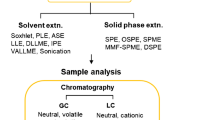Summary
At present, there is an increasing demand for trace gas analytical information, especially in several fields of environmental protection, such as protection of workers from exposure to hazardous substances in work place atmospheres, ambient and indoor air pollution, or gaseous exhalations from polluted soils, waters, or waste deposits. Though the existing powerful trace analytical tools are in principle capable of answering the questions related to these problems, they cannot satisfy the information demand. This is mainly due to the fact that most of these analytical tools are to be used in the course of rather sophisticated multistep procedures which are time consuming and claim high personnel qualification and, thus, are too expensive for large scale application. This difficulty can be overcome by the development of simple one-step procedures based on low price ready-for-use sampling units which can be processed with a minimum of manpower input and, in addition, provide information of the required reliability. One possible way to this goal may be based on the measurement of caloric effects associated with the decomposition of the products resulting during the sampling step from a gas-solid reaction between the traces to be analyzed and suitable solid state reagents. Starting from properly prepared text gas mixtures, the gas-solid reactions of numerous amines, alcohols, aldehydes, ketones, hydrocarbons and halogenated hydrocarbons with several metal complexes and with reagents capable of forming clathrates have been investigated by means of thermoanalytical methods, mainly by means of differential scanning calorimetry (DSC). The results show that in many cases the very simple thermoanalytical evaluation enables both qualitative identification and quantification of the gas traces under concern with satisfying selectivity. These reaction may serve, therefore, as a promising basis for further development of fast, simple and reliable trace gas analysis using thermoanalytical methods.
Similar content being viewed by others
References
Hartkamp H, Buchholz N, Klukas F (1983) Ermittlung und Erprobung von Kalibrierverfahren für Immissionsmeßnetze. Umweltbundesamt, Materialien 3/83, Erich Schmidt, Berlin
Kettrup A (1984) Thermogravimetrie — Differenzthermoanalyse. Analytiker-Taschenbuch Bd 4. Springer, Berlin Heidelberg New York, pp 85–106
Höhne G (1984) Mikrokalorimetrie. Analytiker-Taschenbuch Bd 4. Springer, Berlin Heidelberg New York, pp 107–121
Hemminger WF, Cammenga HK (1989) Methoden der Thermischen Analyse. Springer, Berlin Heidelberg New York
Rittich MJ, Jablonowski M, Hartkamp H (1985) 18-Krone-6 als Sorbens für CH-acide Moleküle aus Luftproben. Fresenius Z Anal Chem 320:58–59
Hollingshead RGW (1954) Oxine and its derivatives. Butterworth, London
Takemoto K, Sonoda N (1984) Inclusion Compounds of Urea, Thiourea and Selenourea. Inclusion Compounds 2:47–67. Academic Press London
Kling H-W, Hartkamp H, Buchholz N (1985) Matrixunabhängige kontinuierliche Dampfraum Gas-Chromatographie. Fresenius Z Anal Chem 320:341–346
Kling H-W (1985) Entwicklung und modellmäßige Beschreibung einer Methode zur matrixunabhängigen HSGC. Dissertation, Bergische Universität — Gesamthochschule Wuppertal
Rottmann J (1985) Beiträge zur Technik der gaschromatographischen Dampfraumanalyse. Diplomarbeit, Bergische Universität — Gesamthochschule Wuppertal
Lübke A (1987) Untersuchungen zum Verteilungsverhalten organischer Substanzen. Diplomarbeit, Bergische Universität — Gesamthochschule Wuppertal
Hedermann D (1986) Entwicklung einer Methode zur Erzeugung von Mehrkomponenten-Prüfgasen für die Gasspurenanalyse. Diplomarbeit, Bergische Universität — Gesamthochschule Wuppertal
Moosbach E, Hartkamp H (1990) Referenzverfahren zur Bestimmung von Stickstoffdioxid-Konzentrationen in Prüfgasen. Staub — Reinhalt Luft 50:87–91
Author information
Authors and Affiliations
Additional information
This work has been carried out with financial support from the Bundesminister für Forschung und Technologie
Rights and permissions
About this article
Cite this article
Hartkamp, H., Rottmann, J. & Schmitz, M. Trace gas analysis using thermoanalytical methods. Fresenius J Anal Chem 337, 729–736 (1990). https://doi.org/10.1007/BF00322246
Received:
Issue Date:
DOI: https://doi.org/10.1007/BF00322246




